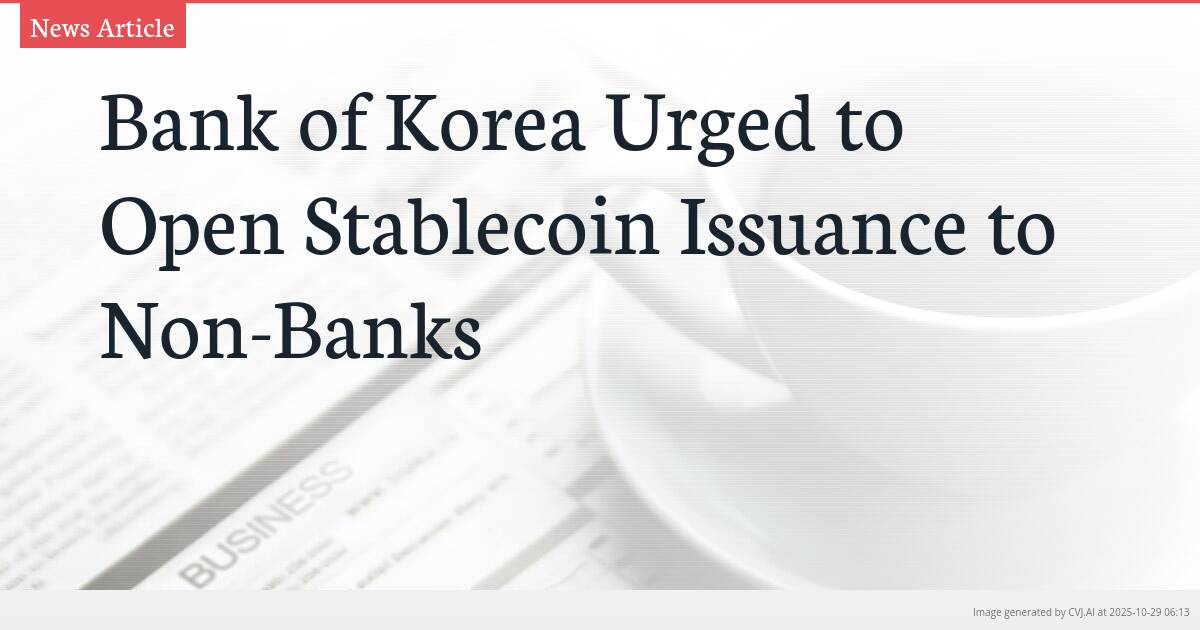This summary text is fully AI-generated and may therefore contain errors or be incomplete.
Introduction
The Kaia DLT Foundation is challenging the Bank of Korea’s proposal to restrict stablecoin issuance exclusively to banks. Foundation chair Dr. Sangmin Seo argues that both banks and non-banks should be permitted to issue won-denominated stablecoins, directly contradicting the central bank’s recent regulatory framework recommendations that favor traditional banking institutions for managing stablecoin risks.
Key Points
- Bank of Korea recommends restricting stablecoin issuance to regulated banks due to existing compliance frameworks
- Kaia DLT Foundation argues this approach lacks logic and should include non-bank issuers
- Central bank proposes multi-agency consultative body to determine issuer eligibility and volumes
The Regulatory Debate Over Stablecoin Issuance
A significant regulatory debate is unfolding in South Korea’s financial sector as the Kaia DLT Foundation directly challenges the Bank of Korea’s position on stablecoin issuance. Dr. Sangmin Seo, chair of the foundation, has publicly stated that the central bank’s push for the banking sector to lead the rollout of won-denominated stablecoins ‘lacks logic.’ This criticism comes in response to the Bank of Korea’s recent report advocating for banks to serve as the primary issuers of these digital assets.
The central bank’s position rests on the argument that traditional banking institutions are already subject to comprehensive regulatory frameworks, including capital requirements, foreign exchange controls, and Anti-Money Laundering protocols. According to the Bank of Korea, these existing compliance structures would naturally help minimize risks associated with introducing stablecoins to the country’s financial ecosystem. However, Dr. Seo contends that this reasoning fails to justify excluding non-bank entities from the stablecoin market.
The Case for Inclusive Stablecoin Regulation
Dr. Sangmin Seo and the Kaia DLT Foundation are advocating for a more inclusive regulatory approach that would establish clear rules allowing both banks and non-banks to issue stablecoins. This position represents a fundamental challenge to the Bank of Korea’s vision of a bank-dominated stablecoin ecosystem. The foundation argues that restricting issuance to traditional banking institutions could unnecessarily limit innovation and competition in South Korea’s emerging digital asset market.
The debate centers on the future of won-denominated stablecoins and which entities should be permitted to create and manage these digital representations of South Korea’s national currency. While the Bank of Korea emphasizes the risk management benefits of working with already-regulated banks, the Kaia DLT Foundation suggests that well-crafted regulations could effectively govern non-bank issuers as well. This disagreement highlights the broader global conversation about how to balance innovation with financial stability in the cryptocurrency space.
Proposed Oversight Framework and Implementation
Beyond the issuer eligibility debate, the Bank of Korea has proposed establishing a policy consultative body that would include currency, foreign exchange, and financial authorities to determine key aspects of stablecoin implementation. This multi-agency approach suggests the central bank recognizes the complex, cross-disciplinary nature of stablecoin regulation. The proposed body would be responsible for deciding on issuer eligibility criteria, volume limitations, and other critical policy considerations for South Korea’s stablecoin market.
The central bank’s comprehensive approach indicates that South Korean authorities are taking stablecoin regulation seriously, recognizing both the potential benefits and risks of these digital assets. By proposing a collaborative regulatory framework involving multiple financial authorities, the Bank of Korea appears to be preparing for the systemic implications of integrating stablecoins into the national financial infrastructure. However, the fundamental question of whether this framework should include non-bank entities remains the central point of contention between the central bank and cryptocurrency advocates like the Kaia DLT Foundation.
As South Korea moves toward establishing its regulatory framework for won-denominated stablecoins, the outcome of this debate will significantly influence the country’s position in the global digital asset landscape. The decision between a bank-exclusive model and a more inclusive approach will determine whether South Korea’s stablecoin ecosystem develops as an extension of traditional finance or embraces the broader innovation potential of blockchain technology and cryptocurrency markets.
📎 Read the original article on cointelegraph.com

